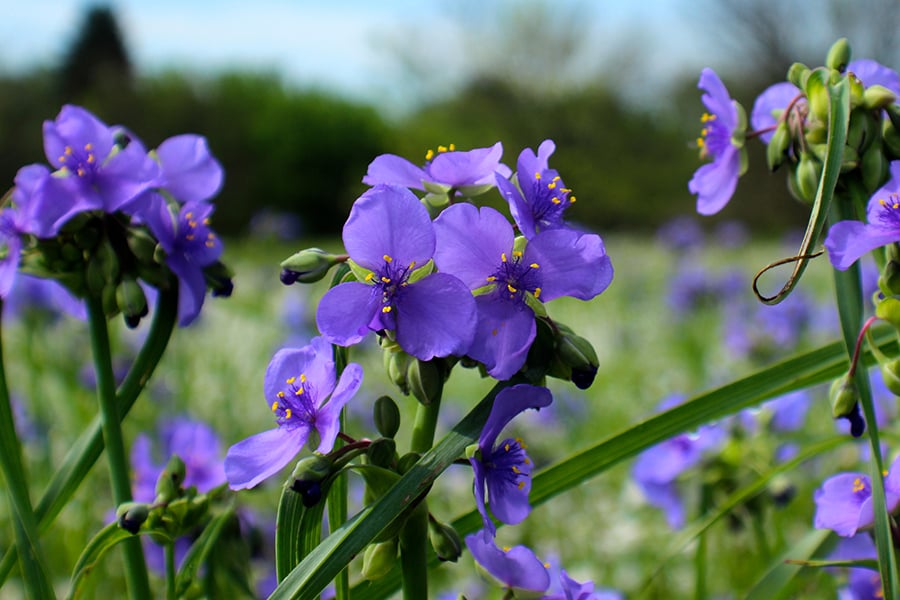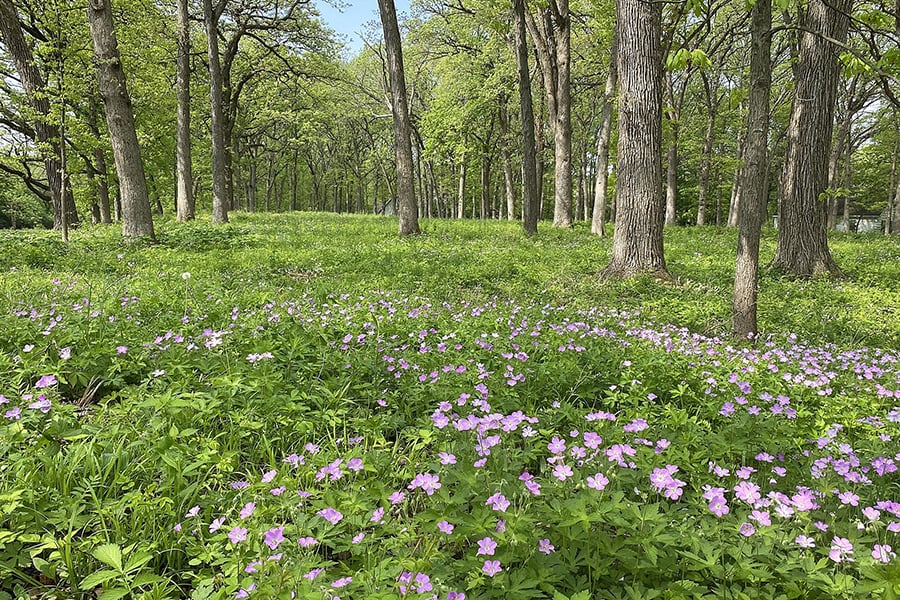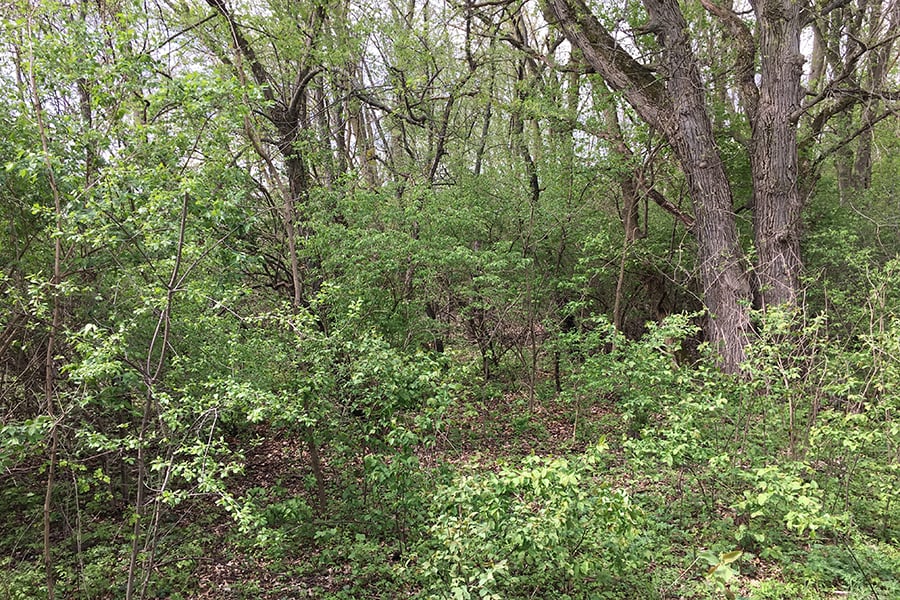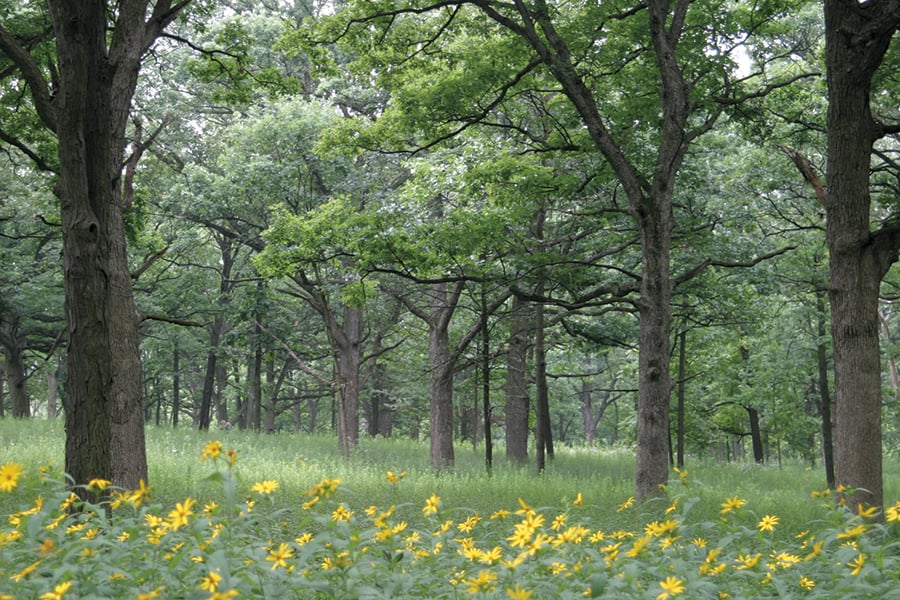
Habitat Restoration
What Is a "Habitat"?
The Forest Preserve District generally uses the words "habitat" and "ecosystem" to talk about similar things.
An ecosystem (or habitat) is basically made up of
- A plant community — a certain group of plants that grow under similar conditions
- The group of wildlife that lives within and relies on that plant community
- Certain soil and moisture conditions, which may be specific to that ecosystem
Although an ecosystem is made up of all of these parts, ecologists categorize them by the plants that live there: prairie, woodland, or wetland.
Prairies are grasslands that contain broadleaved flowering plants, called "forbs," some shrubs, and a few kinds of trees. Depending on the soil, a prairie may be further classified as a dry (usually higher land with sandy or gravely soils that drain quickly), mesic (soils that are fairly moist throughout the growing season), or wet (soils that hold a lot of water).
Woodlands primarily contain trees and are put into general subcategories depending on the spacing between the trees. These categories can range from "forest" — a dense woodland with only shade-tolerant plants below — to "savanna" — an area with sparse trees growing among grasses and forbs typically associated with prairies.
Wetlands are areas covered for at least part of the year with shallow water. Some are easy to identify because they have water year-round, but others may only appear in spring or early summer as "ephemeral," or short-lived, ponds. Wetlands, even ephemeral ones, provide irreplaceable breeding grounds and homes for wildlife from dragonflies, frogs, and salamanders to marsh birds and muskrats.


What Does "Habitat Restoration" Mean?
When the Forest Preserve District talks about a “habitat restoration” project, it’s usually referring to efforts to improve the plant community within a particular ecosystem.
Those efforts, which can take years, include removing invasive plants and then planting or seeding the area with native ones. In these cases, the goal is to create plant communities that can support the plants and wildlife that are normally associated with that particular ecosystem.

overgrown savanna before restoration

healthy, open savanna after restoration
Habitat Restoration Toolbox
Prescription burns are carefully set fires that trained Forest Preserve District employees use in late fall and early spring to remove invasive plants and improve conditions for native species. Read more about them (and check out footage) on our prescription burn page.
Selective clearing is typically done in forests and savannas. Crews remove invasive trees and shrubs, such as European buckthorn and honeysuckle, and selected, aggressive native trees and then burn the brush piles on site. They then carefully apply herbicides to the cut stumps so the plants cannot grow back. Crews may also use heavy-duty mowers to cut shrubs and trees.
Work is done primarily in winter to protect native grasses, forbs, and animals and to lower the risk of fire hazards from burning brush piles. When heavy equipment is used, frozen ground in winter prevents machinery from severely disrupting the soil, too.
Studies show native plants as well as populations of birds and butterflies can recover once selective clearing and mowing removes the weedy vegetation.
Much of DuPage County soil was originally quite wet, so when farmers started turning the land into agricultural fields, many buried channels of clay drain tiles to carry the water away from their fields and pastures.
To date, the Forest Preserve District has removed drain tiles from thousands of acres of forest preserves, allowing the land to again hold water. This not only creates habitat for native plants and animals but also allows the forest preserves to offer valuable stormwater-storage benefits for local residents.
The Forest Preserve District’s nursery at Blackwell Forest Preserve grows nearly 90 different kinds of flowers and grasses. Seed collected from these plants are used in prairie and woodland restoration areas. All the plants are grown from seed collected in remnant areas throughout the county. Seed is never sold but is sometimes traded with other conservation agencies.
See the work we are up to on our Master Plan and Other Projects page.
What Are "Illinois Nature Preserves" and "Illinois Land and Water Reserves"?
DuPage County's forest preserves contain nine areas designated as either an Illinois Nature Preserve or Illinois Land and Water Reserve by the Illinois Nature Preserves Commission, a group that helps landowners protect high-quality natural areas and habitats of endangered and threatened species for perpetuity.
These designations provide the areas with extra protection and limit certain recreational activities, including biking and horseback riding.
These high-quality natural areas make up around 2,668 acres, or 11 percent of the Forest Preserve District's land holdings.
Belleau Woods Land and Water Reserve at Belleau Woods
Brewster Creek Marsh Nature Preserve at Pratt's Wayne Woods
Churchill Prairie Nature Preserve at Churchill Woods
Des Plaines Riverway Nature Preserve at Des Plaines Riverway
Meacham Grove Nature Preserve at Meacham Grove
Springbrook Prairie Nature Preserve at Springbrook Prairie
Springbrook Marsh Land Water Reserve at Springbrook Prairie
Swift Prairie Nature Preserve at Swift Prairie
Truitt-Hoff Nature Preserve at West Chicago Prairie
